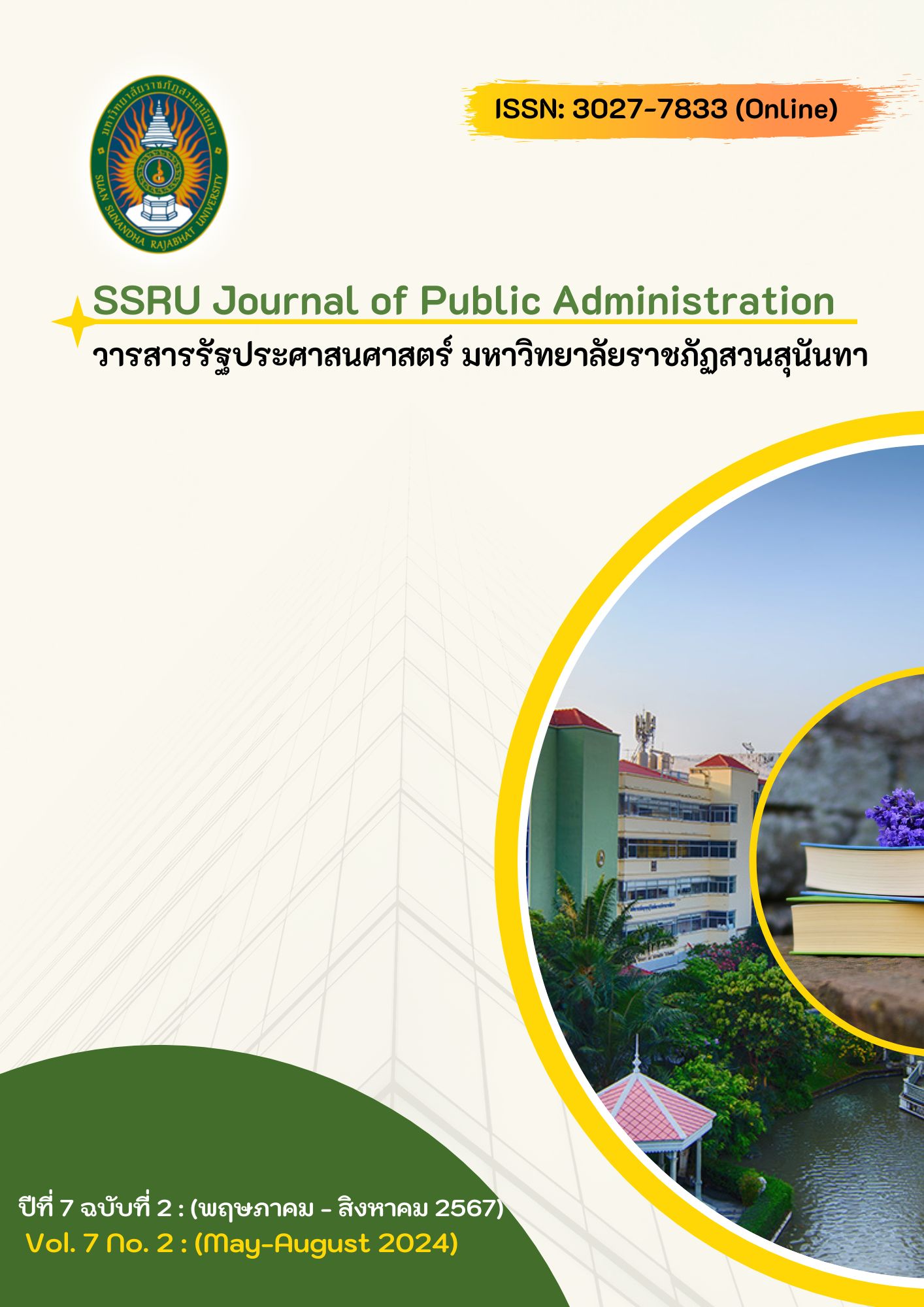ปัจจัยที่ส่งผลต่อการตัดสินใจบริจาคให้กับสตรีมเมอร์ผ่านช่องทางไลฟ์สตรีมมิ่ง
Main Article Content
บทคัดย่อ
การวิจัยนี้มีวัตถุประสงค์ เพื่อวิเคราะห์ปัจจัยที่ส่งผลต่อการตัดสินใจบริจาคให้กับสตรีมเมอร์ผ่านช่องทางไลฟ์สตรีมมิ่ง เป็นการวิจัยเชิงปริมาณ กลุ่มตัวอย่างที่ศึกษา คือ ผู้ใช้แอปพลิเคชันหรือเคยมีประสบการณ์ในการตัดสินใจบริจาคให้กับสตรีมเมอร์ผ่านช่องทางไลฟ์สตรีมมิ่งบนแอปพลิเคชัน ผ่านเว็บไซต์ สมาร์ทโฟน หรืออุปกรณ์อิเล็กทรอนิกส์ต่าง ๆ ในพื้นที่กรุงเทพมหานครและปริมณฑล จำนวน 908 คน
เก็บข้อมูลโดยใช้แบบสอบถามออนไลน์ ด้วยวิธีการสุ่มตัวอย่างแบบชั้นภูมิ และวิเคราะห์ด้วยวิธีการแบบจำลองสมการโครงสร้าง โดยวิธีการประมาณค่าแบบความเป็นไปได้สูงสุด
ผลการวิจัย พบว่าปัจจัยที่ส่งผลต่อการตัดสินใจบริจาคให้กับสตรีมเมอร์ผ่านช่องทางไลฟ์สตรีมมิ่ง ประกอบด้วย ปัจจัยที่ส่งผลต่อด้านพฤติกรรมการบริจาคมากที่สุด คือ ด้านความตั้งใจในการบริจาค รองลงมาคือ ปัจจัยด้านการระบุตัวตนทางสังคมกับผู้ทรงอิทธิพลทางความคิดบนสื่อสังคม รวมทั้งปัจจัยที่ส่งผลต่อด้านความตั้งใจในการบริจาคมากที่สุด คือ ปัจจัยด้านการระบุตัวตนทางสังคมกับผู้ทรงอิทธิพลทางความคิดบนสื่อสังคม, ด้านการคล้อยตามกลุ่มอ้างอิง, ด้านการรับรู้คุณค่า, ด้านการรับรู้การควบคุมพฤติกรรม และด้านทัศนคติ ตามลำดับ
Article Details

อนุญาตภายใต้เงื่อนไข Creative Commons Attribution-NonCommercial 4.0 International License.
เอกสารอ้างอิง
ศุขธัช ชำนาญกิจ, ภัทรวรรธน์ จีรพัฒน์ธนธร และชัยรัตน์ วงศ์กิจรุ่งเรือง. (2564). วิถีอาชีพสตรีมเมอร์และแนวทางการพัฒนาอาชีพสตรีมเมอร์ในทัศนะของสตรีมเมอร์อาชีพ. วารสารครุศาสตร์อุตสาหกรรม, 20(1), 30-40.
อัฌศยา อินทโชติ. (2565). การตัดสินใจติดตามและสมัครเป็นผู้สนับสนุนสตรีมเมอร์บนแพลตฟอร์ม Facebook Gaming (วิทยานิพนธ์การจัดการมหาบัณฑิต). มหาวิทยาลัยมหิดล.
Ajzen, I., & Fishbein, M. (1980). Ajzen and Fishbein's theory of reasoned action as applied to moral behavior: A confirmatory analysis. Journal of Personality and Social Psychology, 38(2), 1-2.
Ajzen, I. (1991). The theory of planned behavior. Organizational Behavior and Human Decision Processes, 50(2), 179–211.
Alzahrani, A. I., et al. (2017). Extending the theory of planned behavior (TPB) to explain online game playing among Malaysian undergraduate students. Telematics and Informatics, 34(4), 239–251.
Blau, P. M. (1964). Exchange and power in social life. New York: John Wiley and Sons: Inc.
Brown, M., Pope, N. & Voges, K. (2001). Buying or browsing? An exploration of shopping orientations and online purchase intention. European Journal of Marketing, 37(11), 1666-1684.
Djafarova, E., & Rushworth, C. (2017). Exploring the credibility of online celebrities’ Instagram profiles in influencing the purchase decisions of young female users. Computers in Human Behavior, 68, 1–7.
Dwivedi, Y. K., Rana, N. P., Tamilmani, K., & Raman, R. (2020). A meta-analysis based modified unified theory of acceptance and use of technology (Meta-UTAUT): A review of emerging literature. Current Opinion in Psychology, 36, 13–18.
Fishbein, M., & Ajzen, I. (1975). Belief, Attitude, Intention, and Behavior: An Introduction to Theory and Research. Boston: Addison-Wesley Publishing Co, Inc.
Humaira, A. & Hudrasyah, H. (2016). Factor Influencing the Intention to Purchase and Actual Purchase Behavior of Organic Food. Journal of Business and Management, 5(4), 581- 596.
Hair, J., et al. (2006). Multivariate Data Analysis (6thEd.). Upper Saddle River, NJ: Pearson Prentice Hall.
Kim, H. W., Kankanhalli, A., & Lee, S. H. (2018). Examining gifting through social network services: A social exchange theory perspective. Information Systems Research, 29(4), 805–828.
Li, Y. (2012). Theories in online information privacy research: A critical review and an integrated framework. Decision Support Systems, 54(1), 471–481.
Liao, G. Y., et al. (2020). How online gamers’ participation fosters their team commitment: Perspective of social identity theory. International Journal of Information Management, 52, 102095.
Marwick, A. E. (2015). Instafame: Luxury selfies in the attention economy. Public Culture, 27(1), 137–160.
Sharma, R., Singh, G., & Sharma, S. (2021). Competitors’ envy, gamers’ pride: An exploration of gamers’ divergent behavior. Psychology & Marketing, 38(6), 965-980.
Sharma, S., et al. (2024). Digital health innovation: Exploring adoption of COVID-19 digital contact tracing apps. IEEE Transactions on Engineering Management, 71, 12272–12288.
Schwarz, A., et al. (2007). Understanding frameworks and reviews: A commentary to assist us in moving our field forward by analyzing our past. ACM SIGMIS Database: the DATABASE for Advances in Information Systems, 38(3), 29–50.
Siddiqui, K. (2003). Heuristics for Sample Size Determination in Multivariate Statistical Techniques. World Applied Sciences Journal, 27(2), 285-287.
Sokolova, K., & Kefi, H. (2020). Instagram and YouTube bloggers promote it, why should I buy? How credibility and parasocial interaction influence purchase intentions. Journal of Retailing and Consumer Services, 53, 101742.
Schouten, A. P., Janssen, L., & Verspaget, M. (2020). Celebrity vs. Influencer endorsements in advertising: The role of identification, credibility, and Product-Endorser fit. International Journal of Advertising, 39(2), 258–281.
smartmathpro. (2566). สตรีมเมอร์ คืออะไร? เริ่มต้นอาชีพนี้ยังไง? รายได้ดีไหม?. ค้นเมื่อ 2 พฤศจิกายน 2566, จาก https://www.smartmathpro.com/article/streamer/
Statistics How To. (2016). Probability and Statistics Topics Index. Retrieved May 2, 2023, from https://www.statisticshowto.com/probability-and-statistics/descriptive-statistics/likert-scale-definition-and-example/
Tran, T. T. (2018). Factors affecting to the purchase and repurchase intention smartphones of Vietnamese staff. International Journal of Advanced and Applied Sciences, 5(3), 107-119.
Uzunoglu, E., & Kip, S. M. (2014). Brand communication through digital influencers: Leveraging blogger engagement. International Journal of Information Management, 34(5), 592-602.


